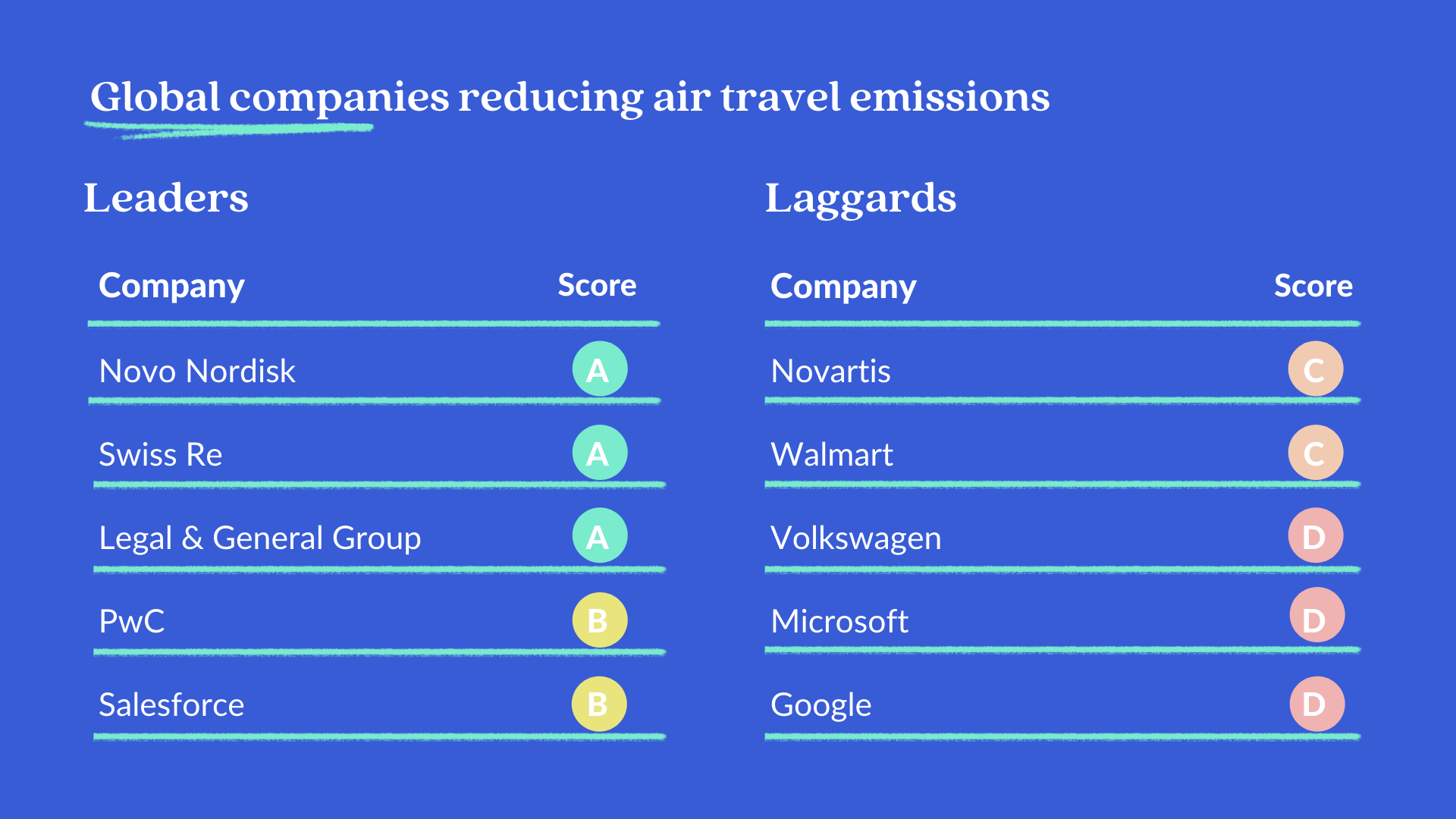A new ranking of corporate air travel reveals that work is underway to reduce emissions by businesses, but more action is needed. Eight companies, including Zurich Insurance Group, Lloyds Banking and Ernst & Young rank highest for their corporate travel emissions reduction plans. Zurich Insurance has pledged to reduce business travel by 70% by 2022. Lloyds Banking will reduce corporate flying by 50% by 2021 and Ernst & Young by 35% by 2025.
The ranking, launched as part of T&E and Stand.Earth’s new Travel Smart campaign, grades 230 US and European companies according to nine indicators, relating to emissions reduction targets, reporting and air travel emissions. The analysis sheds light on the significant efforts certain global businesses have still to make to reduce their corporate travel emissions. Out of the 230 companies, 193 fail to act with sufficient speed and ambition to tackle corporate travel emissions.
The likes of Vodafone, Renault & L’Oréal have all made company-wide emissions reductions targets but no commitment to reduce corporate air travel emissions by a certain date. They could be encouraged to make ambitious business travel commitments in line with the reduction they experienced in 2020, helping to reduce global greenhouse gas emissions in line with 1.5°C warming scenarios. Businesses like Google, Facebook and Microsoft lie in the ranking’s lowest category and must accelerate their transition to becoming smart travelers, T&E says.

Denise Auclair, corporate travel campaign manager at T&E, said: “The pandemic proved that businesses can be as effective and even more efficient by flying less and reducing their emissions at the same time.Whilst some companies in Europe and the US show that reducing emissions from business flying is possible, others like Volkswagen and Accenture are dragging their feet. Cutting down on business travel makes economic sense for companies, and also protects employee wellbeing. Whilst leaders and citizens are crying out to reduce our dependence on oil, smarter traveling is an easy way to do so.”
A company with an A score has an absolute reduction commitment for air travel, some of which are aiming for a 50% or higher reduction target by 2025. These companies have been reporting their business or air travel emissions for more than a year. The businesses meet the ranking’s highest standard for corporate travel and set the example for other corporations. Eight companies (3%) in the ranking reach that score. The Danish pharmaceutical company Novo Nordisk comes out on top, with its 50% reduction target by 2025 and transparent reporting of air travel emissions for the past three years.
Transport & Environment and Stand.Earth, together with a coalition of global partners, have launched the Travel Smart Campaign and a new corporate ranking at a crucial time for the travel industry, as business flying is starting to pick up post-pandemic. In 2019, business travel accounted for about 15 to 20% of air travel[1], or about 154 million MtCO2. But the sector experienced a huge shock with the Covid pandemic and business travel spending declined by 52% in 2020, from 1.4 trillion USD in 2019 to 694 billion USD in 2020[2].
Companies now have a unique opportunity to lead by innovating new practices, adopt air travel emissions reduction targets and lock in the lower emissions habits they acquired during the pandemic. T&E’s Roadmap to climate neutral aviation showed that a reduction in corporate travel was the single most effective way to reduce aviation emissions in the short term, where it counts most for the climate. By reducing corporate travel by 50%, we would cut emissions by 32.6 MtCO2 by 2030 in Europe, which is the same as taking 16 million polluting cars off the road[3].
The new Travel Smart campaign asks companies to:
- Commit publicly to an absolute target of at least 50% reduction in flying of 2019 levels, by 2025 or sooner;
- Implement reductions in flying and choose other modes of connectivity and transport;
- Report on progress towards decreased emissions.
Denise Auclair added: “Traveling smart is about making every single meeting count. Although not all business travel by plane can be avoided, virtual meetings are an effective substitute in many cases. We have done it for two years, so why stop now? Many companies have already announced targets to cut corporate flying by 50%. The path is clear for others to equally step up, fly less and achieve more.”
Note to editors
[1] McKinsey & Company, The Travel Industry Turned Upside Down Report, September 2020, https://www.mckinsey.com
[2] Global Business Travel Association (GBTA), Business Travel: Full Recovery Expected by 2025, February 1, 2021. https://www.gbta.org/blog/business-travel-full-recovery-expected-by-2025/
[3] Transport & Environment, Roadmap to climate neutral aviation in Europe, 2022, /uploads/files/legacy/TE-aviation-decarbonisation-roadmap-FINAL.pdf


